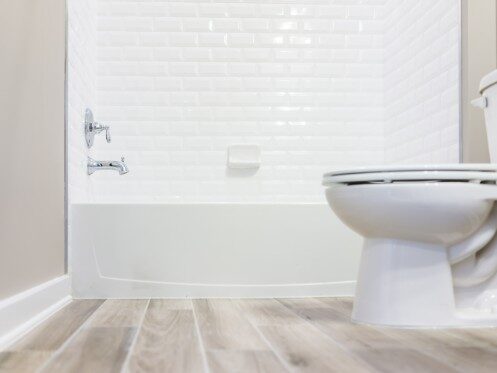Clogged toilets are one of the most common plumbing problems we all have to deal with occasionally. A severely clogged toilet can be a big problem as the bowl could quickly start to overflow when you flush and send water and waste flooding out into your bathroom. When dealing with a clogged toilet, most people reach for a plunger or pour a bunch of drain cleaner into the bowl. Both of these methods can be effective at clearing clogged toilets and pipes, but they also have the potential to cause leaks and serious damage to your plumbing. Today we’re going to give you some advice on what to do and what not to do when dealing with a clogged toilet and also what other options you may have for clearing the clog.
Never Use Drain Cleaner
Most professional plumbers you’ll ask will tell you that pouring drain cleaner down the toilet or into your pipes is always a bad idea. Drain cleaners are great at eliminating even stubborn clogs as they contain strong chemicals that will quickly start to eat through and dissolve most solid materials. The issue is that these chemicals are strong enough that they can damage and weaken pipes as well. If you use drain cleaner frequently, the pipe will eventually weaken to the point that it begins to leak, and you’ll need to have it replaced.
Some drain cleaners, especially crystal drain cleaning products, also work by creating a chemical reaction that produces a huge amount of heat. This product is even worse for your plumbing as the heat can easily cause PVC pipes to warp and start leaking or have a vastly shortened lifespan. This potential damage to your plumbing is why we recommend avoiding chemical drain cleaners if possible. Another reason is that there are also other methods that can work to clear the clog just as well without risking your plumbing.
Only Use a Plunger When Necessary
Plungers can also be an effective option for unclogging a toilet, but we would still recommend only plunging your toilet when absolutely necessary. If you just flushed the toilet and the water is quickly rising in the bowl, then you should grab the plunger to see if you can prevent the toilet from overflowing. If the toilet is only partially clogged and not at risk of overflowing, we would usually recommend trying some other option first.
Plungers work by creating a vacuum and producing a large amount of pressure that forces the clog out of the pipe. The issue is that using a plunger too forcefully has the potential to damage the drain line and cause it to start leaking. If the toilet is severely clogged, a plunger may force the clog further down the drain line. This can then lead to your bathroom sink and shower drain also becoming clogged, as they sometimes share the same drain line as the toilet.
All this being said, plungers can still be safe and effective when used properly. The main thing to remember is to never try to use too much force. If the plunger doesn’t clear the clog when you apply a normal amount of force, calling a plumber is the best option as applying too much force could damage your plumbing.
Another thing to consider is that plungers only work when there is sufficient water in the bowl. If the water level doesn’t completely cover the plunger, it won’t be able to create a vacuum and won’t have any effect on the clog. You also need to make sure that the plunger completely covers the toilet drain and creates a tight seal. To ensure the plunger does seal tightly, you may want to run it under hot water for a few seconds, as this will help loosen up the rubber so that it creates a better seal.
Common Household Options for Unclogging a Toilet
If your toilet is completely clogged, the water obviously won’t drain at all. In this case, your only real option is to try to use a plunger and then call in the help of a plumber if the plunger doesn’t clear the clog. If the toilet is only partially clogged, it will still typically drain, just much more slowly than normal. In this situation, we would recommend trying a few other options before you reach for the plunger.
One option that works surprisingly well for clearing more minor clogs is to simply pour hot (not boiling) water into the bowl and let it sit for 10 minutes or so. Of course, this is only an option if there is only a small amount of water in the bowl. In this situation, you will want to turn your sink on as hot as it will go and fill up a large pot with hot water. You can pour the water into the bowl until it is around two-thirds full. After letting the water sit, try to flush the toilet again to see if it is still clogged. You should also be able to tell if the hot water successfully loosened the clog as the bowl will start to drain before you flush it.
Another option that can be even more effective is to pour 4 or 5 tablespoons of liquid dish soap into the toilet bowl before you add the hot water. After pouring in the dish soap, let it sit for around 10 minutes, so it has time to make it’s way down through the toilet to the clog. You can then pour in hot water and wait a few minutes more to see if the clog goes away and the toilet drains. The dish soap acts as a lubricant that can help make the clog slide down the drain more easily once it’s loosened by the hot water.
Baking soda and vinegar can also be an extremely effective option for unclogging a toilet if there isn’t too much water in the bowl. All you need to do is pour 1 cup of baking soda into the bowl, followed by 1 cup of white vinegar. You will then want to wait around half an hour before adding hot water to the bowl. The bubbling action from the baking soda and vinegar can help to loosen the clog, and then the hot water should help break it up even further so that all of the solids easily flow down the drain.
Always Call a Plumber for Severe Clogs
If you have a toilet that is completely clogged and it remains clogged after using your plunger, as we discussed above, you are always best off calling a plumber instead of risking further damage to your plumbing system. In most cases, the plumber will use a toilet snake to quickly and effectively eliminate the clog without damaging the toilet or drain line. A toilet snake consists of an auger connected to a metal cable. The plumber will feed the cable down the toilet and into the drain line until it reaches the clog. The auger is then turned and acts like a drill bit that breaks through the clog so that all of the waste and water can then easily flow out of the drain line.
At Cal’s Plumbing, we specialize in drain cleaning and can help if your toilet is clogged or you have a clog anywhere else in the home or out in your main sewer line. We also specialize in all other types of residential plumbing services as well as water heater and water treatment services. Contact us today if you have any questions or need plumbing services in the Tucson area.






